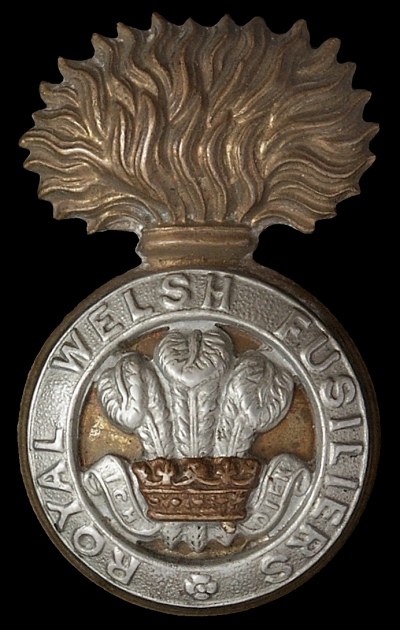

Charles William Edwards
(known as 'Charlie')
then
Royal Army Service Corps
Private 285179
then
Royal Welch Fusiliers
10th Battalion
Private 60488
 |  | |
Charles William Edwards(known as 'Charlie') | ||
| Coldstream Guards (?) then Royal Army Service Corps Private 285179 then Royal Welch Fusiliers 10th Battalion Private 60488 | ||
| Killed 26th September 1917 |
Charlie Edwards' Parents | ||
|
Harry Edwards (father) Harry Edwards came from Norwich and was the son of a ‘clicker’, which was a person who cut the leather for the uppers of shoes and boots. He was one of six children. It is not known what happened to Harry’s parents, but the deaths of both his father and mother were registered in the same quarter (Oct-Dec) of 1881, when he was just 10 years old and his youngest brother Herbert was just one year old. Harry and Herbert then came to Bath. In 1891, when Harry was 20, he was an ‘inmate’ of Uplands Cottage on North Road, which was known as the Orphan Apprentice Home and superintended by a Mrs Clarkson, whose husband was a churchwarden at St Matthews. This was an institution run at the time by 34-year-old matron Emma Maggs, who was running a home for 11 young men, all of whom were completing apprenticeships in various trades. Sales particulars for Uplands Cottage mention four bedrooms plus a box room, so it does seem to have been at least three young men to a bedroom. Harry himself was listed as a bookbinder’s apprentice at that time.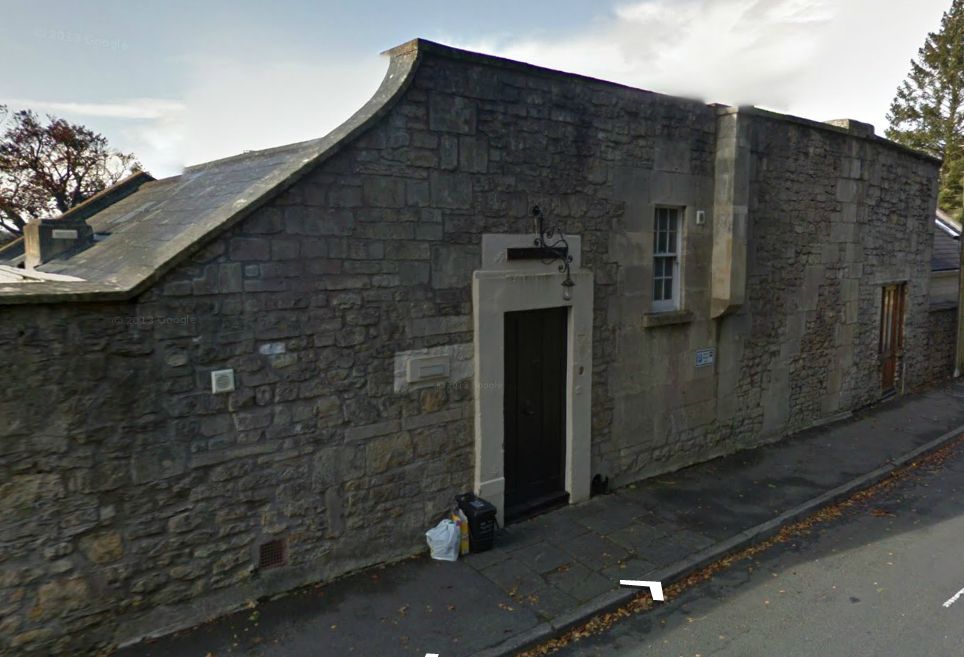 Uplands Cottage, North Road At the same time, Harry’s younger brother Herbert (then aged
11) was nearby at the ‘Williamson’s Orphanage’ (founded in the 1860s by a Miss
Williamson) on Claverton Down in Bath. Research appears to show that this was
at 3, Oakley. This was run at the time by Mrs Emma Mould, whose husband Charles
was listed as a builder (of the company Mould Brothers of Northgate and Westmoreland); he was
also one of the churchwardens at St Matthews at the time. We can
deduce that the orphanages were in some way linked to the church, or supported
by a significant benefactor within the parish who then looked to the church
community for support in running the charity. There does also seem to be a link
with the widow of a retired priest (Rev Williamson) in the parish. The orphanage
household comprised Mr & Mrs Mould, their two children, a servant, a
boarder and fourteen male orphans. A counterpart home for female orphans was at
numbers 2 & 6 Macauley Buildings on Widcombe Hill. It is not certain what happened to
Harry’s three elder siblings (Edwards is a common name and Norwich a large
city),
but a sister named Rachel (born between Harry & Herbert) appears on
the 1891 census in service in a household at Kirkham, Lancashire. It
does seem that the death of the parents tore this family unit apart. Minnie Pitman (mother) Whereas Charlie’s
father came to Bath from the far-flung eastern county of Norfolk, his mother,
Minnie Pitman, was born and spent her early years in Cornwall. Her parents were
both from Bath families, but her father was a coastguard with the Navy and
stationed at various places around the coast at different times. Her eldest
brothers had been born in Bristol, but Minnie herself was born in the village
of St Columb, inland from Newquay (now near Newquay airport) in 1874 and the
1881 census showed the family living at St Minver, inland from Trebetherick,
near Polzeath. In 1891, the family was back in Bath, living at 7 Walcot
Terrace. Her father was, at age 52, a Naval Pensioner, so had retired back to
his native Bath subsequent to concluding his coastguard work. Minnie was a
dressmaker, living with her parents and one younger sister at that time, whereas
ten years previously there had been seven children – with five brothers – in
the family. The three elder brothers would have been 19, 20 & 21, so had
understandably moved on. (It is quite difficult to trace people with the names
William, Richard and Ernest Edwards, born Bristol, as there are multiple
matches). A further brother (Hector)| had died in childhood in Cornwall in 1885
and another (John) had died in an accident on naval training vessel HMS Ganges
at Falmouth in 1890. | ||
The Edwards Family |
|
Harry & Minnie were married in 1895 at St Swithin’s,
Walcot. |
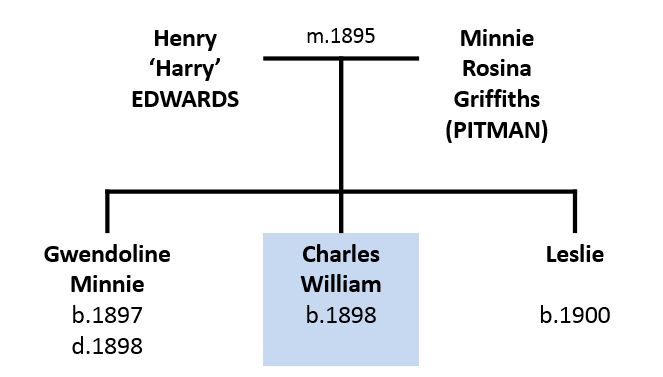 |
| The Bath Directory lists the family living at 33 South Avenue from 1897-1900. The first child, Gwendoline, was born in 1897, but died in 1898, the same year that Charlie was born. The third and final child, Leslie, was born in 1900. |
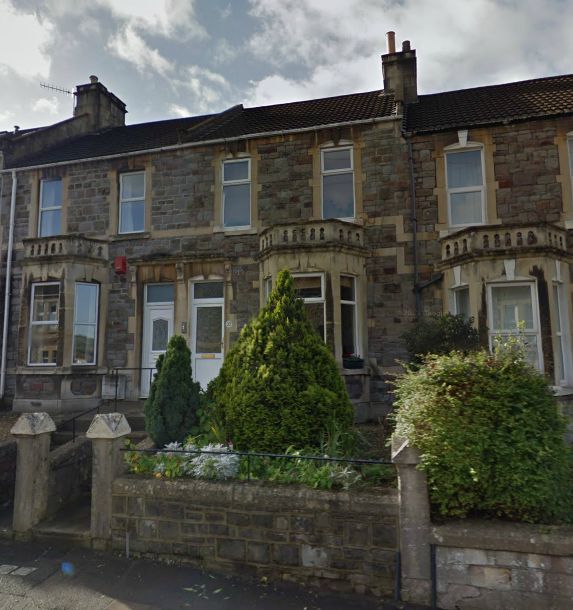 | ||
|
33 South Avenue |
|
The 1901 census shows the family had moved a few streets
away and was living at 15 Lyndhurst Road, with father Harry still working as a
bookbinder. The family remained at this address until 1913, so it was the address from which Charlie Edwards walked to school at South Twerton, which he would have attended from 1904-1911. |
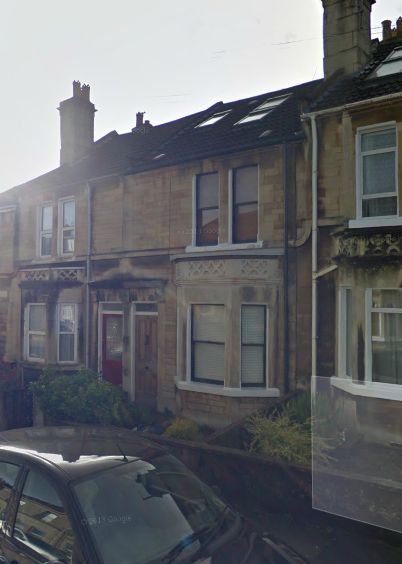 | ||
|
15 Lyndhurst Road |
|
In the years before the war, Charlie attended the City of Bath Secondary School, which was in the Guildhall. In 1932, this school became the City of Bath Boys School and relocated to new premises at Alexandra Park. In 1970, the school became Beechen Cliff School. In 1913, the Edwards family moved to 20 Walcot Parade, where father Henry had his bookbinding business. |
Charlie Edwards in WW1 | ||
|
After the outbreak of war, the Bath Chronicle & Weekly Gazette posted lists of the men joining up for military service under the title ‘Our Citizen Soldiers’. Men were soemtimes listed by employer; this was probably done to encourage employers to allow their men to join, as this would have been favourable publicity in that climate. Also, individual parishes posted lists of those who had joined up and a 'Charlie Edwards' was listed by St Marks Parish on 17th October 1914, cited as having joined the Coldstream Guards. It is however not certain that this was the same Charlie Edwards, as we believe that he was by this time living in Walcot. Records relating to his death, however, show that he died while serving with the Royal Welch Fusiliers, 10th Battalion and that he was previously with the Royal Army Service Corps. Royal Welch Fusiliers, 10th (Service) Battalion The 10th
Battalion’s involvement in the war was as follows (from The Wartime Memories Project): 10th (Service) Battalion, The Royal Welch Fusiliers was raised at
Wrexham on the 16th of October 1914 as part of Kitchener's Third New Army and
joined 76th Brigade, 25th Division. They moved to Codford St Mary for training
and spent the winter in billets in Bournemouth. They moved to Romsey on the
29th of April 1915 and then to Aldershot for final training on the 3rd of June
1915. They proceeded to France, landing at Boulogne on the 27th of September
1915. On the 15th of October 1915 the Battalion transferred with 76th Brigade
to 3rd Division. In 1916 they took part in The Actions of the Bluff and St Eloi
Craters then moved to The Somme for The Battle of Albert, The Battle of
Bazentin helping to capture Longueval, The Battle of Delville Wood and The
Battle of the Ancre. In 1917 they were at Arras, seeing action at Battles of
the Scarpe and The Battle of Arleux. They moved north to the Flanders and were
in action during The Battle of the Menin Road and Battle of Polygon Wood during
the Third Battle of Ypres. | ||
Charlie Edwards'Death at the Third Battle of Ypres / Paesschendaele | ||
|
Charlie was killed on 26th September 1917 in the battle of Paesschendaele (Third Battle of Ypres). From the Imperial War Museum website: The Third Battle of Ypres is frequently known by the name of the
village where it culminated: Passchendaele. In Britain it has come to symbolise
the horrors associated with the war on the Western Front. The area surrounding the Belgian town of Ypres was a key battleground
during the First World War. By 1917 British forces were suffering steady
casualties there, holding a salient surrounded by higher ground. Sir Douglas
Haig planned to break out of this poor position and seize the railway running
behind the German lines, a few miles east. He then hoped to advance on the
German submarine base at Bruges. The German U-boat campaign was threatening
Britain with defeat at this time. A preliminary operation to seize the Messines Ridge was a dramatic
success, but the Germans had reinforced their position by the time the main
battle was launched on 31 July. The initial attacks failed, due to
over-ambitious plans and unseasonal rain. The drainage of the low-lying
battlefield had been destroyed by the bombardment, so mud made movement
difficult. Better results were achieved during a dry period in September,
demoralising the Germans, who did not have an answer to the British 'bite and
hold' tactics. Encouraged, Haig insisted on continuing the offensive in
October; despite the return of the rain and appalling mud. The Canadians
finally captured Passchendaele ridge on 10 November, but the vital railway
still lay five miles away. Both sides had suffered heavy casualties on this frightful battlefield,
but the British Expeditionary Force had made no strategic gain. | ||
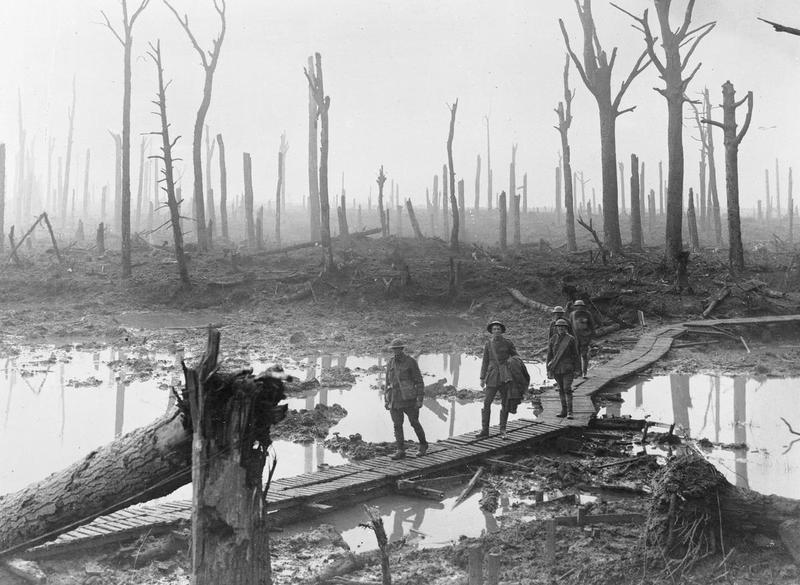 | ||
|
Australian troops walk along a duckboard track through the remains of
Chateau Wood, Third Battle of Ypres .
[Photo: Imperial War Museum collection © IWM (E(AUS) 1220)]. |
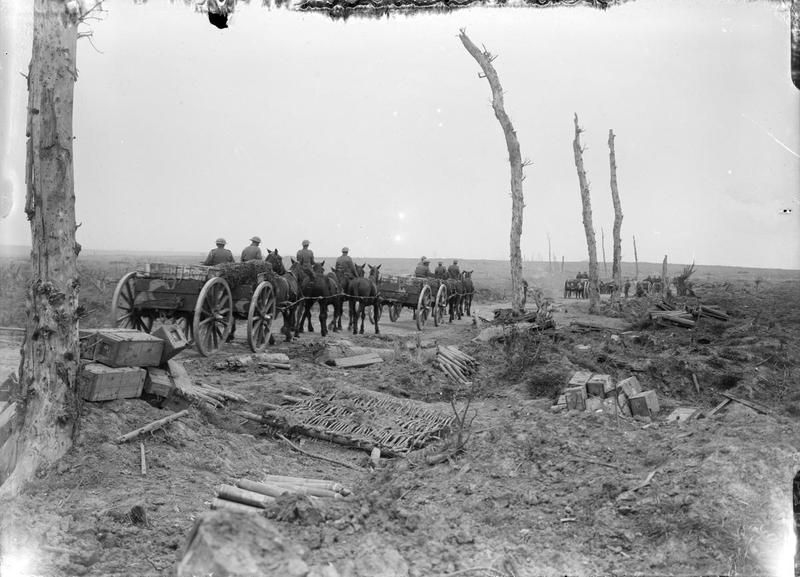 | ||
|
The Menin Road out of Ypres on 26th Sept 1917, the
day Charlie Edwards died in these fields in the Third Battle of Ypres. [Photo: Imperial War Museum collection © IWM (Q 2905)]. |
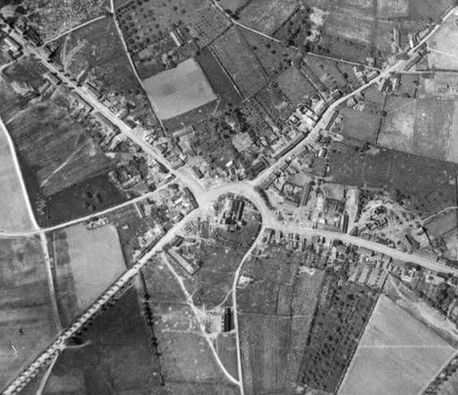 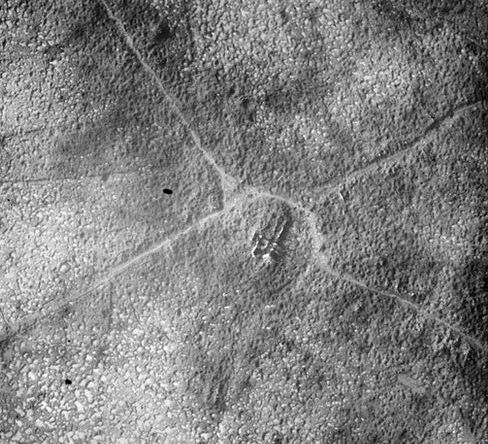 | ||
|
The village of Paesschendaele before and after the battle. Only the
ruined church remains in a sea of mud, churned, burned and pock-marked by
artillery. [Photos from BBC website]. |
|
Listen to a BBC programme on Passchendaele here. |
Unit Diary
The unit diary of the 10th Bn. Royal Welch
Fusiliers survives and is available from the National Archive with the file
name WO/95/1436. Here are the diary entries for the days leading up to the date
of his death: Saturday, September 22nd: WATOU Fine. Parades under Company arrangements in the morning in the vicinity of the camp. Inter-Company cricket matches in the afternoon. Major A.J.S. JAMES MC with 1 officer (Sec, Lieutenant E. SWAINSON) and 27 Other Ranks proceed to trenches to take over the assembly positions for the 76th Infantry Brigade. Sunday, September 23rd: WATOU Fine. Church Parades in the morning. Battalion parade and march to camp at BRANDHOEK in the afternoon Monday, September 24th: BRANDHOEK Fine. Battalion practised attack. Tuesday, September 25th: BRANDHOEK Battalion entrained at BRANDHOEK and detrained at about 8.0pm at YPRES Asylum Railway Station where Companies were met by guides under 2/Lieut. E SWAINSON. Train was bombed en route. These guides had been rehearsed over the tracks to assembly positions by Major A.J.S. JAMES MC for several days prior to Zero day. Battalion moved by platoons at 100 yards intervals to Brigade H.Q. which consisted of an enemy concrete redoubt just behind assembly positions, Platoons were met here by further guides under 2/Lieut. R.T. OWEN who conducted troops to their taped positions. The Battalion was safely in position by midnight. The rear company suffered casualties when crossing HANNEBEKE. Wednesday, September 26th: YPRES Our bombardment commenced at 3.40am, enemy artillery retaliating 30 minutes later inflicting several casualties. At Zero hour, the advance commenced in a very heavy ground mist. The Brigade was disposed as follows: 8th K.O.R.L.R. [King’s Own Royal Lancashire Regiment] on right, 1st Gordon Highlanders on left:
2nd Suffolk Regiment on left, 10th R.W. Fus. on right:
Final objective included the village of ZONNEBEKE. The leading troops lost direction to a certain extent, bearing to their left to avoid the STEENEBEKE. After crossing the STEENEBEKE, the advance continued towards the 1st Objective. This was reached without suffering undue losses and under cover of our barrage.Re-organisation was carried out. On the lifting of the barrage, the R.W.F. continued their advance to the final objective. The ruins of an old hut caused some trouble but on working round the flanks the garrison surrendered. It was during the final advance the Battalion suffered most. After crossing the ZONNEBEKE, very few men were to be seen and heavy
M.G. fire was coming from the direction of the station. The Right company
however succeeded in reaching the Church, which was entered by Capt. A.W. FISH
and 14 men closely followed by a few men of the Suffolk Regt. The Left was held up at a point 200 yards
from the Station with its left on the Railway Embankment. Shortly afterwards touch was obtained with the Royal Scots Fusiliers, the other side of the embankment. There was a gap of about 200 yards between the right half and left half Battalion. This area was entire swamp and was covered by our flanks and a party of 1st Gordon Highlanders in rear. The enemy showed little fight during the advance except on approaching our final objective. At one strong point near ST JOSEPH’S INSTITUTE a German officer with eight men and a Machine Gun surrendered to a Lance Corporal. A large number of the enemy were captured and killed and a considerable number of wounded found. At 2.30pm the first counter-attack was launched. A large number of Germans succeeded in getting through our barrage and reached a point 100 yards in front of our left company. It was stopped by resolute and steady Lewis Gun and Rifle Fire. Very heavy casualties were inflicted on the enemy irrespective of the losses he incurred from our artillery barrage. At this juncture the Brigade on our left was driven in but owing to the resolute fighting of the 76th Brigade (not a single man gave an inch of ground) the left Brigade was able to restore the position later in the evening. About this time Lt.-Col. D.S. COMPTON-SMITH D.S.O. reported at Brigade H.Q. with “Shell Shock” and Major A.J.S. JAMES M.C. was sent for and assumed command of the Battalion. The position in the front line at this time was very grave owing to the withdrawal of the left Brigade the left flank of the R.W.F. was uncovered and the majority of the men were down to their last clip of ammunition. 2/Lieut. H.C. HUNTER and E.G. WILLIAMS immediately organised parties and got a quantity of ammunition from casualties and a party of 1st Gordon Highlanders in rear immediately responded to our call for S.A.A. [small arms ammunition] and Lewis Gun Magazines. Rum and S.A.A. were sent up
during the night and the Companies re-organised as far as possible.
The announcement in the Bath Chronicle & Weekly Gazette in October 1917.
|
Decoration | ||
| Private Charlie Edwards would have received the following medals posthumously. He may also have received the 1914-15 Star, but there is uncertainty about when he joined the Welch Fusiliers from the Royal Army Service Corps. This is something we need to clarify. | ||
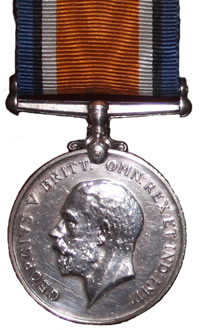 | 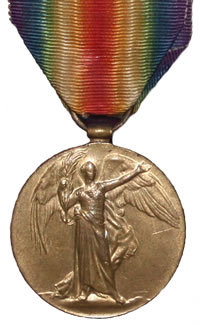 |
| British War Medal 1914-18 | Allied Victory Medal |
Commemoration | ||
 In addition to his commemoration on the South Twerton School memorial, Private Charlie Edwards is commemorated as follows: | ||
|
Tyne Cot Charlie Edwards is commemorated at the Tyne Cot Memorial, between Zonnebeke and Passendale (formerly Paesschendaele) in Belgium. This cemetery is the largest Commonwealth war cemetery in existence. When it became clear that the Menin Gate memorial in Ypres (designed to list the names of soldiers whose grave’s location was unknown) was going to be too small, panels were erected at Tyne Cot. Soldiers who died after 15th August 1917 are listed at Tyne Cot. |
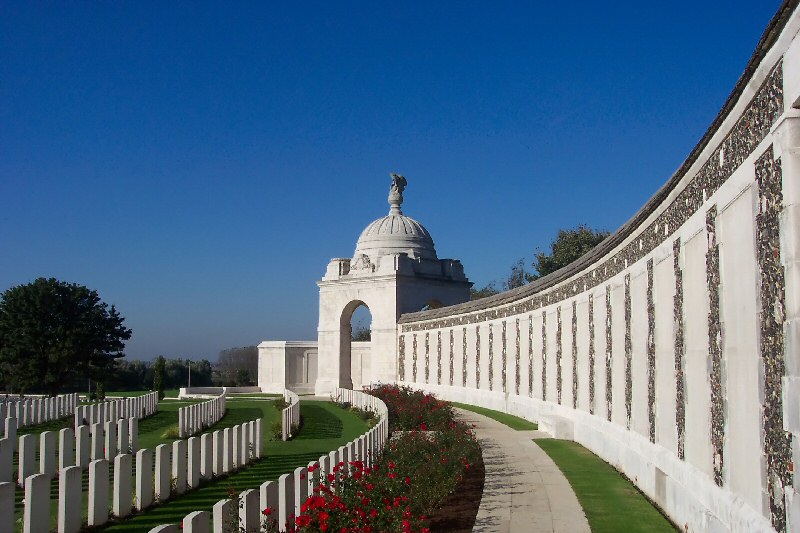 |
|
Bath War Memorial See separate page for details of the Bath War Memorial. Charlie Edwards' inscription: |
 |
|
Walcot Parish Memorial, St Swithins Church We know that the Edwards family moved to Walcot Parade in 1913 and Charlie is listed on the parish war memorial in the parish church, which takes the form of two white marble tablets, mounted either side of the entrance, on the rear wall of the church. Please see the separate Walcot Parish Memorial page for more details of this memorial. Charlie's inscription: |
 |
|
Bath Secondary School Memorial (now at Beechen Cliff School)
Having attended the City of Bath Secondary School, Charlie Edwards is commemorated on the memorial which now resides in the stair well of the 1930s school site that is home to Beechen Cliff School.His inscription: |
 |
Further Information |
Other Family MembersIn 1914, the Edwards family home had moved to 20 Walcot Parade and Charlie’s younger brother Leslie is cited in the results of a Bath Cycling Club sports day on the Recreation Ground, running in the 4x220 yards relay and representing Bathforum School (which stood opposite the Griffin pub on Monmouth Street). There he also was among the recipients of prizes at the school prize-giving in July 1914. In 1915 Leslie was attending a shorthand school in Northumberland Buildings. Leslie survived the war; being born in 1900 he was too young to serve for most of its duration and in 1915 he joined the GWR, so may have been in a ‘protected’ occupation. The following Bath newspaper articles from the 1940s show that Leslie acheived a very senior position within the railway company.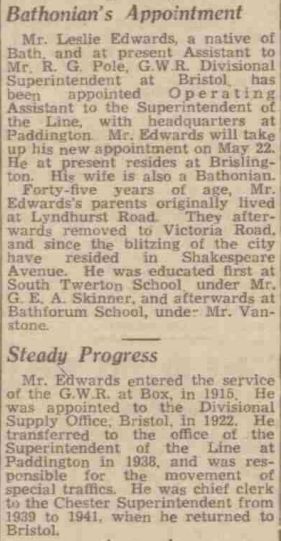 May 1946 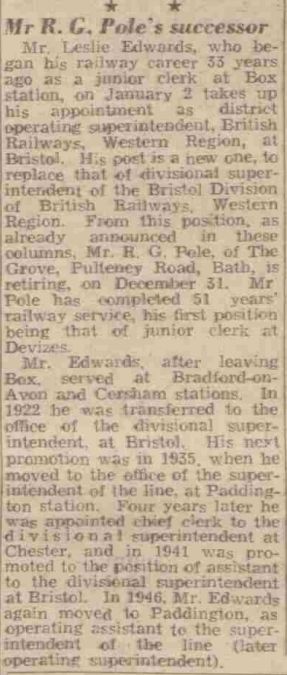 December 1949 Living relativesIt would be great to hear from any living relatives of Charlie Edwards. These will probably be descended through his brother Leslie. Please get in touch!If you have any further information on Charlie Edwards, or want to suggest corrections / improvements for this page, please use the Contact page to get in touch.All additions and further information will be credited appropriately. |